(This article follows an article about how I became a paperboy and a second article about how I delivered newspapers and a third article about paper-route economics.)
From the beginning of my paperboy career, I understood the importance of increasing the number of customers on my route. The time I spent delivering papers every day was practically constant. Delivering one more newspaper took almost no more time, but my profit increased by more than a penny a day.
I did more arithmetic. If a new customer subscribed to both the daily and Sunday deliveries, then in a year, my increased profit at the end of the year would total (42¢/month * 12 months = ) $5.04. If I put that extra profit into my savings account at Cattle Bank, then at a 3.5% interest rate I would earn 18¢ interest every year afterwards -- EVERY YEAR AFTERWARDS !! -- PLUS COMPOUNDING !!!
And that was just for one more customer. My brain feverishly fantasized about the profitable results of several new customers added to my route every month.
During the first couple of months after I took over my paper route, I spent a couple of hours on Saturday afternoons knocking on doors of non-subscribers in my route area and trying to sell subscriptions.
I had read the guidance in The Newspaper Carrier's Handbook about how to sell subscriptions. The following pages depicted the paperboy scouting for prospects on his route and then approaching those prospects to sell subscriptions.
 Click here to see the above two pages fully in larger sizes.
Click here to see the above two pages fully in larger sizes.
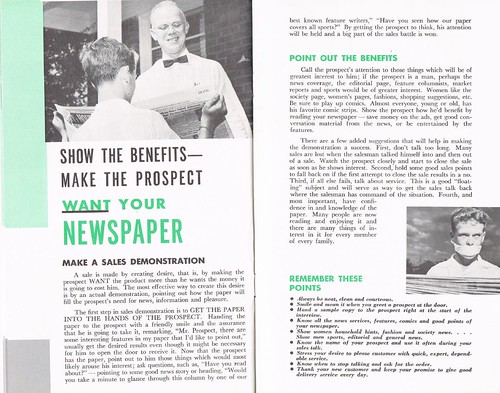 Click here to see the above two pages fully in larger sizes.
Click here to see the above two pages fully in larger sizes.
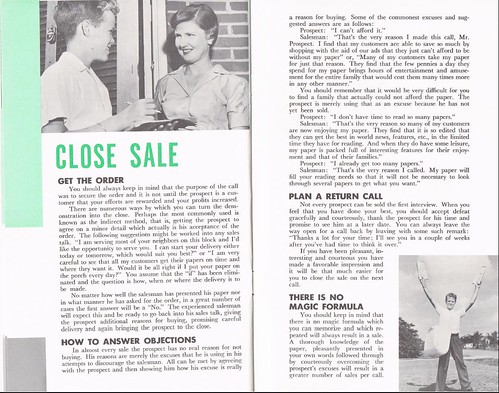 Click here to see the above two pages fully in larger sizes.
Click here to see the above two pages fully in larger sizes.
There also were various sales instructions like this ...
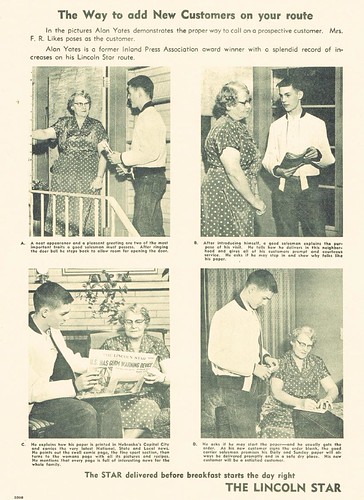
Click here to see the above leaflet in larger sizes.
... and this.

Click here to see the above leaflet in larger sizes.
I did not have the self-confidence or the ability, however, to sell like the boy in the manual did. I was only nine years old and was easily intimidated. When I knocked on a door and someone opened the door, the conversation usually went like this:Me: Hi, would you like to subscribe to The Lincoln Star?
Adult: No, thanks. [Closes door]
After a few such Saturday afternoons of rejection and frustration, I gave up.
However, the newspaper's distribution office in Lincoln regularly conducted various contests and prizes to entice the paperboys into trying to sell subscriptions. One popular prize was a group trip to the state fair in Lincoln. If all the paperboys in a district together sold a total of so many new subscriptions in a particular time, then all the paperboys (even paperboys who did not sell any subscriptions at all) got to go to the state fair for a day.
I would try to sell subscriptions when the prize was a trip to the state fair. I cannot remember whether I did sell any subscriptions on those occasions (maybe a sold a few) but I always got to go to the state fair, because all the paperboys in the district sold enough for everyone to go.
The trips to the state fair were a lot of fun. In the morning we paperboys would fill a bus, which drove us to Lincoln and dropped us off at the fair. I think each of us received some discount coupons for rides and games. Then in the evening the bus would drive us all back to Seward.
The state fair had a much larger selection of rides and attractions than the county fair in Seward had. The state fair had some burlesque attractions. There were some view machines, where you put a coin in the machine and then you looked into a visor and saw a short film of a woman dancing around in lingerie. Then the woman would start to take off their lingerie and the scene would go black. There also was a live burlesque show with real women dancers. I was too young to get into that, but a couple of the very oldest paperboys were allowed to enter. I spent a few coins looking into the viewing machines. A couple of the guys bought some playing cards that were illustrated with pictures of women with lingerie, and those guys would show the cards around in the bus on our ride back to Seward. This was the funnest day of the year for us paperboys.
During the first year that I worked as a paperboy, a bunch of us won a trip to watch the University of Nebraska's football team play a game. There were a lot of empty seats in the stadium, because the team always had a bad record in those days. Paperboys were allowed to attend free as a promotion, just to fill some of the seats. I remember that we boys spent more time running around and playing in the stands then watching the football game. (The Cornhuskers began to win football games and become popular after 1962, when Bob Devaney became the coach. My father sat next to Devaney on an airplane flight and had a conversation with him when Devaney was flying from Wyoming to Nebraska to take over the coaching job.)
After I quit working as a paperboy, there was one subscription contest where the prize was a trip to Omaha to go on a tour of the Strategic Air Command (SAC) air base. My brother Steve Sylwester went on that trip.
I remember one subsciption-selling contest where I did sell a couple of subscriptions. One summer afternoon each of us paperboys received a phone call telling us we were supposed to report immediately to the home of Austin Neihardt, Seward's distribution manager, for an important meeting. This never had happened before. I rode my bicycle to Neihardt's, where the living room was filled with paperboys. A distribution manager from Lincoln introduced himself and gave each one of us a small catalogue showing prizes we could win for selling subscriptions. The prizes were very attractive. Then he told us that we would get triple credits for all the subscriptions that we sold by 7 p.m. on that very day and double credits for all the subscriptions that we sold by the end of the weekend.
Of course, all we paperboys raced out immediately on our bicycles to our route areas and tried to win these prizes. That day I sold one subscription, and then I sold another subscription by the end of the weekend. The I won a good Swiss Army pocket knife and a couple of other prizes. Normally we had to order our prizes from the catalogue and wait a few weeks to receive them in the mail, but when I returned to Neihardt's house at 7 pm with my first new subscription, the manager had one of the prize knives with him, and so he gave me that prize immediately. I opened the blade and barely touched it to my finger tip, and the blade was so sharp that it cut my skin and caused me to bleed. What a cool knife!
That particular contest has stayed in my memory for several reasons -- the unexpected phone call, the catalogue, the sharp knife and my immediate success selling two subscriptions. This success bothered me, because I felt that I probably could have sold more subscriptions during those years if I had continued to try regularly. I could have improved my sales skills and could have earned more money. I pondered my inadequate effort and sales failure often during my last months as a paperboy.
I did sell a few subscriptions by giving prospects the newspaper free for a week. On the first day we would leave the first day's newspaper at the foot of the door and hang this announcement on the prospect's doorknob.
In my experience, this method worked rather well -- certainly much better than knocking on doors with cold calls. I think that about half of the prospects who received the newspaper for a week eventually subscribed. I wanted to use this method more often, and I do not remember why I did not. Maybe I was supposed to take more initiative and propose good prospects to the district manager. Or maybe these free newspapers were a bonus for paperboys who already were selling more subscriptions with other methods.
In general, my attitude, effort and service declined significantly during the last year or two that I delivered newspapers. I got up later and later and delivered the newspapers later and later. I dawdled. I forgot to deliver papers to some customers. The number of subscribers declined to a lower number than when I had begun delivering the route. I became dissatisfied with the amount of money I earned, but I did not want to make any effort to sell subscriptions.
I made a special effort to deliver the newspapers early only during the month before Christmas, because most of my customers gave me a Christmas bonus. Some customers gave a cash bonus -- as much as five dollars. Other customers gave me boxes of candy. During the Christmas break from school, I would spend my days eating boxes of chocolate-covered cherries and watching television (Jack Benny movies, Bob Hope and Bing Crosby movies, Judy Garland and Mickey Rooney movies, Abbott and Costello movies, etc.).
A major reason why my attitude declined was that I foresaw that I would be able to work in the Concordia College cafeteria during my eighth-grade year. That job payed 60¢ an hour and did not include exposure to freezing, windy weather. I could foresee an escape from my paper route and a big step up in my employment.
For some boys, delivering a newspaper route was the beginning of a life-long career in entrepreneurial business. I, however, grew up in a family of teachers and pastors, and so during those young years I had no role models or mentors or coaches who provided guidance and encouragement for a business career. When I think back at that experience of delivering newspapers, I cannot escape the conclusion that I did not succeed as I initially hoped I would succeed and perhaps could have succeeded.
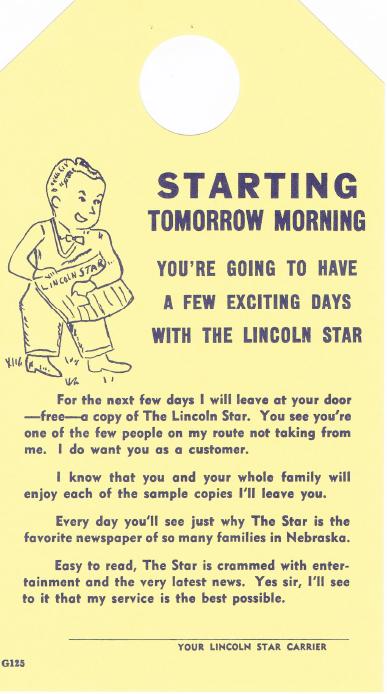
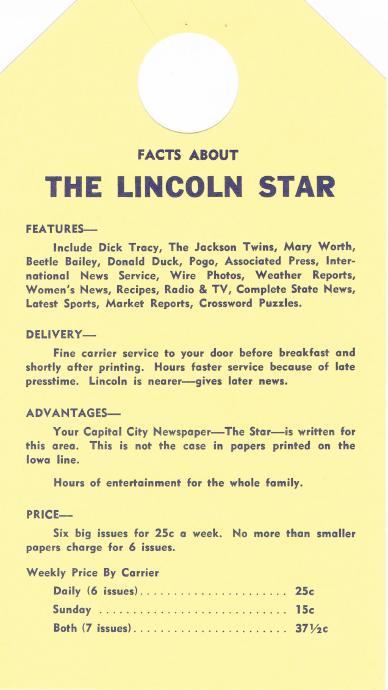

No comments:
Post a Comment